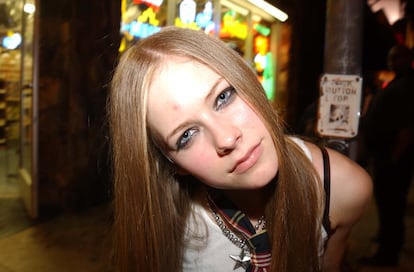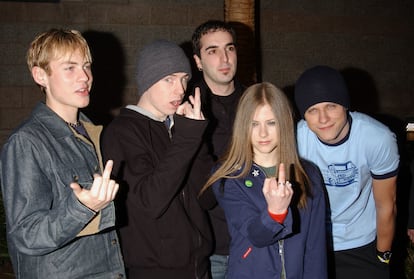Avril Lavigne: The conspiracy theory, the disappearance and the rebirth of the star who embodied rebellion for Millennials
Driven by ‘grunge’ nostalgia and TikTok, the Canadian singer is enjoying a comeback with a tour that has attracted good reviews at Glastonbury

Elvis Presley is not alive, Paul McCartney is not dead, and David Bowie was not an alien. On this much, we can all agree. But what about Avril Lavigne? Did she really die in 2002, and has someone physically identical named Melissa Vandella been pretending to be her all this time? Of all the urban legends and nutty theories that six decades of pop music have sparked, surely the one starring the Canadian singer is the one that has the largest number of gullible followers. So much so that just a few months ago, when Lavigne, 39, gave an interview on the Call Her Daddy podcast to present her greatest hits tour, the host, half joking and half serious, asked her: “So, is your name Avril Lavigne or Melissa Vandella?” The singer wasn’t too bothered and replied: “Obviously I’m Avril Lavigne.” Obviously…
One of the reasons why this crazy theory has made more headway than others is to be found in the digital universe and its viral expansion, as well as in a career with too many ups and downs and prolonged silences. In the early 2000s, two young singers were fighting for the crown of commercial pop: Britney Spears and Christina Aguilera. Both wielded the same weapons: after an adolescence spent working at Disney, they launched themselves into the adult world with catchy songs, short skirts and cute messages. They both sported blonde hair. And then Avril Lavigne showed up: grim-faced, wearing dark baggy pants, a tie over a t-shirt, straight hair that covered half her face and almost always posing with her middle finger raised. Her music also ran along the same rails of rebellion: the guitar on top, the grungy voice, the accelerated melody.
She sang with a frown and used tons of black mascara. Her first album, Let Go (2002), shipped 14 million units, the majority bought by young people who longed to be different, who did not understand the world they were living in and who were too young when Kurt Cobain was bawling about his vital discomfort. But Avril caught them at the right moment: in that transition from adolescence to young adulthood, where they needed a reference to put into words what they were thinking and feeling. And even better if it was put to music. Grunge angst for teens. That was Lavigne and her studded wristbands.
In her first hit, Complicated, she criticized a boyfriend who behaved like a stupid macho man when he was with his friends. “I see the way you’re acting like you’re somebody else, gets me frustrated,” sang a young woman who was only 18 years old. She also talked about flirting with boys while riding around the city on a skateboard (as in Sk8er Boi) and how unenthusiastic she was about the adult world.

Could her music be considered punk? Lavigne herself settled the matter in an interview at the time: “They say I do punk, but punk is so not commercial, unlike what I’m doing. I’m not punk, I never said I was punk.” Her music was always defined with nuances: punk-pop, pop-rock. Her success rode on the back of a lightning bolt, and from the moment she released that first album, she was already filling concert venues in the United States.
Lavigne’s musical uprising came after a constrained childhood in a small town of 5,000 residents (Napanee, in the Canadian province of Ontario) and in a family of fiercely devoted Christians. Little Avril took advantage of Sunday Mass to sing, even if it were prayers to Jesus. She began performing in libraries and schools. At one of these performances there was a professional manager who perceived her potential. He sent tapes with her songs to a dozen record companies, and a multinational responded. And everything exploded with the first album. Her second work, Under My Skin (2004), followed the same lines, with songs that managed to capture the malaise of twenty-somethings, such as My Happy Ending, Nobody’s Home or Don’t Tell Me.

However, her third album, The Best Damn Thing (2007), was a shock for her most loyal fans. She swapped black for pink, took off her skater pants, put on a skirt, and her sound softened as much as chewing gum. The song that led the album, the pop treat (without punk or rock) Girlfriend, climbed to the top of the sales charts, but this change discredited her warrior-like essence. It was at this time that the story of her death spread, which had allegedly occurred years before due to depression (no further details are given: not everything is explained in conspiracy theories), leading to her replacement by a double. It also coincided with a long period of silence: four years without an album partly due to problems with the record company (“they wanted me to record music that I didn’t identify with,” she said) and with a complicated divorce from Deryck Whibley, singer of the band Sum 41.
When she returned in 2011, she had lost her place. Lady Gaga was attending awards ceremonies in dresses threaded with beef steaks, Rihanna had turned the world into a dance floor with Load and Adele swayed listeners with her intense ballads. There was no trace of punk-pop, rock-punk or pop-rock in the sales charts. She was not at her best either, getting on her followers’ nerves with songs like Hello Kitty (2013), a light K-pop piece.

She was only remembered when the urban legend about her death repeatedly went viral. She continued releasing albums, always with the aim of recapturing that rage of her first two albums. In 2014, the bad news continued: she was diagnosed with Lyme disease, caused by a tick bite, which prevented her from leading a fully active artistic life due to persistent fatigue, headaches and joint pain. Six years of recording silence, with some dramatic television appearances where she said, between sobs, that due to the consequences of the disease she had accepted death.
Then, in 2021, came the rebirth. And what more conducive place to lift a sinking career than the social platform TikTok, always receptive to the return of broken toys. The singer’s fun videos, her youthful attitude and those grumpy songs from her early days have accumulated followers on her personal account. Now she’s on the road again, taking advantage of all this nostalgia with a Greatest Hits Tour, where she has packaged her top dozen hits into an infallible recital for the millennial generation, today in their thirties and forties. The concert she gave at the Glastonbury Festival last week was rated four stars out of five by The Guardian’s not-so-benevolent critic Alexis Petridis. Who knows, maybe Avril Lavigne still has time to get her musical career back on track. After all, she is only 39 years old.
Sign up for our weekly newsletter to get more English-language news coverage from EL PAÍS USA Edition
Tu suscripción se está usando en otro dispositivo
¿Quieres añadir otro usuario a tu suscripción?
Si continúas leyendo en este dispositivo, no se podrá leer en el otro.
FlechaTu suscripción se está usando en otro dispositivo y solo puedes acceder a EL PAÍS desde un dispositivo a la vez.
Si quieres compartir tu cuenta, cambia tu suscripción a la modalidad Premium, así podrás añadir otro usuario. Cada uno accederá con su propia cuenta de email, lo que os permitirá personalizar vuestra experiencia en EL PAÍS.
¿Tienes una suscripción de empresa? Accede aquí para contratar más cuentas.
En el caso de no saber quién está usando tu cuenta, te recomendamos cambiar tu contraseña aquí.
Si decides continuar compartiendo tu cuenta, este mensaje se mostrará en tu dispositivo y en el de la otra persona que está usando tu cuenta de forma indefinida, afectando a tu experiencia de lectura. Puedes consultar aquí los términos y condiciones de la suscripción digital.
More information
Archived In
Últimas noticias
Welcome to the post-religion era: The idea of Christianity as the absolute truth has become obsolete
‘I thought you would like it’: The risky sexual practice popularized by TV shows and TikTok
The digitalization of tourism: ‘They promise experiences and gave us the worst possible one’
Mexican peso defies uncertainty with forecasts of a new period of stability in 2026
Most viewed
- Sinaloa Cartel war is taking its toll on Los Chapitos
- Reinhard Genzel, Nobel laureate in physics: ‘One-minute videos will never give you the truth’
- Oona Chaplin: ‘I told James Cameron that I was living in a treehouse and starting a permaculture project with a friend’
- Why the price of coffee has skyrocketed: from Brazilian plantations to specialty coffee houses
- Silver prices are going crazy: This is what’s fueling the rally











































